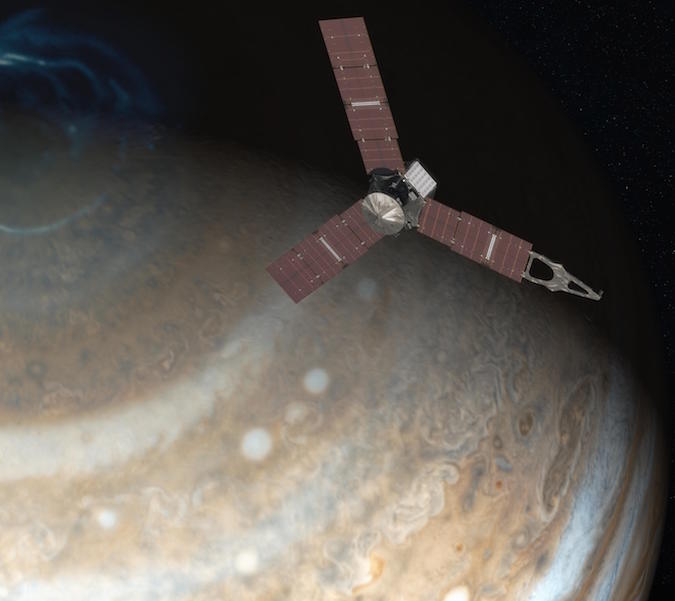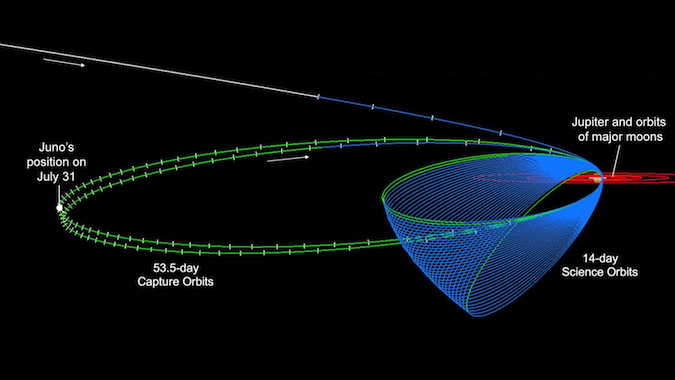
Concerns about the health of the Juno spacecraft’s main engine have compelled NASA managers to keep the research probe in its current arcing, high-altitude orbit around Jupiter, a decision that will delay the full science return from the $1.1 billion mission but should still allow it to meet all predetermined objectives.
Juno fired its main engine to brake into orbit around Jupiter on July 4, 2016, maneuvering into an egg-shaped 53-day orbit that takes the spacecraft several million miles from the giant planet on each circuit.
At the low end of the orbit, the spacecraft passes within 3,000 miles (5,000 kilometres) from Jupiter’s cloud tops, permitting Juno’s instruments to peer deep into the atmosphere, measure the planet’s extreme magnetic field and radiation belts, observe its auroras, and take the first detailed images of its poles.
But engineers called off another engine burn planned for Oct. 19 to put Juno in a tighter 14-day orbit, the science perch envisioned by mission managers since the project’s inception. Most of Juno’s scientific observations occur when the probe is closer to the planet, and the 14-day orbit was designed to give researchers rapid-fire data returns during close approaches every two weeks.
Ground controllers noticed two helium check valves inside the spacecraft’s main propulsion system did not behave as expected during pressurization of Juno’s propellant tanks about a week before the planned Oct. 19 engine firing. The valves opened in several seconds before previous engine burns, but took several minutes to open in October.
Rick Nybakken, Juno’s project manager at NASA’s Jet Propulsion Laboratory, told Spaceflight Now that engineers recommended canceling the maneuver and keeping the craft in its current 53-day orbit after a multi-month investigation.
“The project recommended not doing the burn,” Nybakken said in a Feb. 17 interview. “We’re in a great science orbit, the spacecraft is healthy, the instruments are healthy. We’re getting incredible science, and it’s teaching us more about Jupiter, and there are a lot of very interesting surprises about Jupiter, so we recommended not to take any additional risk that might jeopardize that — not to do this burn — and ultimately NASA Headquarters agreed with that recommendation.”

According to Nybakken, experts considered an option in which Juno’s Leros 1b main engine, designed and built by Moog-ISP in the United Kingdom, could have fired in a backup “blow-down” mode using residual tank pressure, bypassing the suspect check valves. In a normal burn, the check valves would actuate to regulate pressure in the propellant system feeding the thruster.
Officials decided the risk of doing a “blow-down” burn was too great, Nybakken said. Any problem during such an engine firing could have stranded Juno midway between the 53-day and 14-day orbits in a less optimal perch for science observations.
In the 53-day orbit, Juno will avoid flying through Jupiter’s shadow, keeping the craft’s power-generating solar panels in sunlight. If Juno ended up in an unplanned lower orbit because of a sub-optimal engine burn, the probe would have flown through a series of eclipses in 2019, starving it of sunlight and likely ending the mission.
The choice not to execute the orbit-lowering burn preserves the option to use Juno’s smaller maneuvering thrusters to steer clear of Jupiter’s shadow and keep the mission going beyond 2019.
“It wasn’t so much that the risk was unacceptable, it’s just that if anything off-nominal were to happen, you bring in these mission-ending eclipses in 2019,” Nybakken said. “In our current orbit, the size of the orbit is large enough, and the time of the orbit helps give us the operational latitude to avoid those eclipses.”
Nybakken said the inquiry into Juno’s propulsion woes did not determine a root cause for the sticky valves. Officials quickly decided against using the valves for a “regulated” burn, and instead studied the backup “blow-down” option before eventually concluding Juno’s orbit should not be lowered at all.
“At a high level, one of the leading theories is that we can have a very low level of interaction at the vapor level between fuel and oxidizer, and it can create products that can interfere with proper valve operation,” Nybakken said. “Beyond that, it is kind of to be determined. We didn’t require root cause to realize the valves are not working as intended.”

Engineers ruled out any link between Juno’s propulsion problem and engine failures on two geostationary communications satellites last year, Nybakken said.
The commercial Intelsat 33e and the U.S. Navy’s MUOS 5 communications satellites were to use on-board engines to raise their orbits to geostationary altitude 22,300 miles (35,800 kilometres) above Earth’s equator after launching in June and August 2016. Both satellites had to use backup thrusters to finish the job.
Nybakken said those engine failures were unrelated to the issue aboard Juno, and engineers with JPL and Lockheed Martin — Juno’s prime contractor — cleared the Leros 1b engine on the Jupiter orbiter in October, before encountering the sticky check valves.
“There were a couple of failures last fall that we looked into, and we were able to determine that those failures did not represent any sort of increased risk to Juno,” Nybakken said. “And after we completed that investigation, we were, in fact, planning to go ahead with this maneuver.”
One benefit of Juno’s predicament is the higher 53-day orbit will keep the spacecraft away from the worst of Jupiter’s intense radiation belts, which harbour hazards that mission designers believed would limit the mission’s duration to some time in 2018.
“It turns out in the 53-day orbits, we cross the equator, where the radiation belts are, much farther out, so we have much less radiation dose,” Nybakken said. “Of course, with the orbits being larger, the dose as a function of time is much slower as well.”
Juno’s next close pass by Jupiter is set for March 27, completing its fifth orbit of the planet since last year’s arrival.
“Juno is healthy, its science instruments are fully operational, and the data and images we’ve received are nothing short of amazing,” said Thomas Zurbuchen, associate administrator for NASA’s science mission directorate in Washington, in a statement. “The decision to forego the burn is the right thing to do — preserving a valuable asset so that Juno can continue its exciting journey of discovery.”
The Juno mission is funded through July 2018, for a total of 12 science orbits, down from the 32 science orbits originally planned, NASA said in a statement.
Juno’s science team can then propose to continue the mission for another two years as part of NASA’s senior review process, in which a panel of independent researchers recommend to the agency which of its planetary science missions should continue to receive federal funding.
“Juno is providing spectacular results, and we are rewriting our ideas of how giant planets work,” said Scott Bolton, the mission’s principal investigator from the Southwest Research Institute in San Antonio. “The science will be just as spectacular as with our original plan.”
“We’re very excited about what we’ve seen so far, and every time we fly by the planet it’s like Christmas time,” Nybakken said. “The data is stunning.”
Email the author.
Follow Stephen Clark on Twitter: @StephenClark1.



